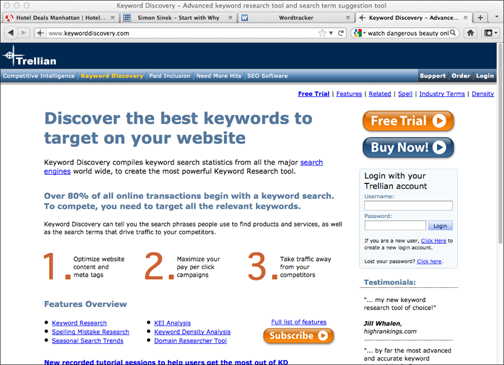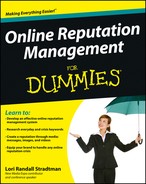Figure 6-1: A Google search for site: social-media-design.com.
Researching Your SEO Keywords
After all this suspense you’re doubtless ready to dive in to your keywords with reckless, overjoyed abandon. It is actually one of the smartest things you’ll ever do for your entire online strategy. It’s the geeky glue that holds it all together. Let’s begin!
Understanding indexing
Indexing is just a scary word for how Google and Bing are keeping track of your site. To evaluate your site, their search engines “crawl” your site periodically, take snapshots of your site, and index them. It’s interesting to see what’s in there and what isn’t. If you’re a design addict like me, pay close attention to these results, if only to see how you are being represented to the world via search engine results. You may be surprised.
Your main concern should be to find out what entries Google and Bing are storing in connection with your site. When you know what sites show up, you can take action to eliminate sites you don’t like and to promote the sites that work for you.
How can you see what Google or Bing lists about your site? Just follow these steps:
1. Go to Google.com
or Bing.com
.
2. In the search textbox, enter the term site: and then the exact URL of the site you want to evaluate.
If your site is myfreakingawesomesite.com, then your search should be for: site:myfreakingawesomesite.com. Figures 6-1 and 6-2 show what a search for site:social-media-design.com looks like.
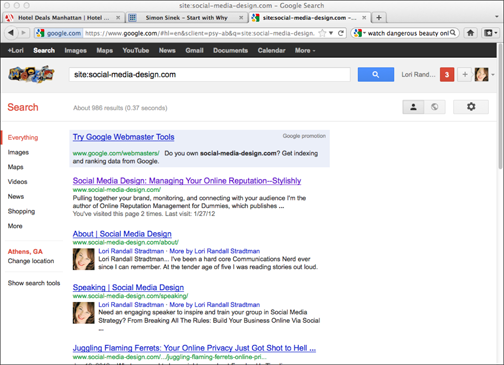
Figure 6-2: A Bing search for site: social-media-design.com.
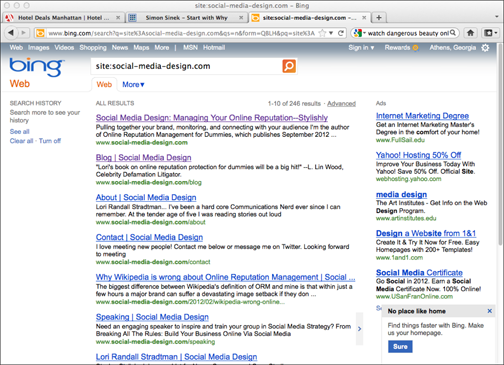
Google will show you a list of the pages it’s indexed for your site. I encourage you to take stock of what you see and to set some benchmarks for your online reputation growth. If your site’s been around for a couple of years and you have only a handful of indexed pages, then it’s time to get started with a redesign. It may be the smartest thing you ever do to establish and maintain a vibrant online reputation.
Here are some important things to look at:
![]() The underlined part: It’s a hyperlink and it comes from a part of your site’s HTML called the Title tag.
The underlined part: It’s a hyperlink and it comes from a part of your site’s HTML called the Title tag.
![]() The text part: It comes from that description metatag I told you about earlier in this chapter. Casual visitors won’t see the metatag — they’ll only see the awesome content you create for them.
The text part: It comes from that description metatag I told you about earlier in this chapter. Casual visitors won’t see the metatag — they’ll only see the awesome content you create for them.
![]() The URL part: This may represent a “cached” link. Click on it to see a stored page that Google saved from the last time that it crawled this page. This can be mighty handy if this page on your site got damaged or lost. Your IT pro will back me on this.
The URL part: This may represent a “cached” link. Click on it to see a stored page that Google saved from the last time that it crawled this page. This can be mighty handy if this page on your site got damaged or lost. Your IT pro will back me on this.
All other major search engines in the Western world get their information from Google and Bing, so unless you’re interested in a deep exploration, just look at those two search engines and your every SEO wish will come true, sort of. At least you’ll be over 97 percent covered.
Beginning your keyword research
As you embark on your keyword research, I suggest starting with the smartest, easiest place on earth, which is your website’s analytics report. This report tracks how users get to your site and what they do when they get there. Website analytics are an awfully handy tool for discovering the search terms that brought people to your site in the past. If these terms are relevant, you need to put them at the top of your list of keywords.
Once you’ve looked through your analytics for relevant search terms that people are already using to find you, it’s time to play some guessing games about what search terms people are using that will lead them to relevant information on your site.
Playing guessing games
You could almost make a party game at the office with this activity. I may sound silly, but it really is important to be at your creative best while brainstorming for your potential keywords. They’re a powerful storyteller for your brand online, and you want to get it right, which can be surprisingly deceptive sometimes.
Here’s a good approach:
1. Create a situation where everybody’s as fresh and relaxed as possible and write down a list of ideal words and phrases that you’d like to be searched on that are relevant to what you do.
2. If your organization is tied to a geographical area (like a house painting service), then add that region.
For example: “Happy Hippie Housepainters of San Francisco.” If that’s your business name, run with it via your geographical area. This should be your first keyword. Create several, depending on the size and activities of your organization.
3. List important terms, such as those that describe your organization, services, and products.
4. Review these results with each other and see what develops.
Using the Google AdWords tool
Google’s AdWords tool is not only free, but it’s also the best tool to use in your quest for the most viable keywords for your brand. (See Figure 6-3.) AdWords should not be the only tool in your proverbial SEO keyword toolbox, but it’s the most respected and widely used one. Here are a couple handy features within that toolbox that you can explore:
![]() Keyword Selector Tool:
Keyword Selector Tool: https://adwords.google.com/select/KeywordToolExternal
![]() AdCopy Brainstorm Tool:
AdCopy Brainstorm Tool: https://adwords.google.com/select/AdTargetingPreviewTool
Figure 6-3: Google AdWords tool.

With AdWords, keyword research can be really fun. I like to approach it while I’m feeling fresh and creative because you never know what brainstorms may come up that help you to refine how you want to present yourself to the world online. Google’s AdWords tool is marvelously versatile. It can perform in-depth, targeted search analyses and use comparisons for the following kinds of things:
![]() All the wonderful keywords you thought up earlier
All the wonderful keywords you thought up earlier
![]() Phrases that you feel people will search for when looking for your brand
Phrases that you feel people will search for when looking for your brand
![]() Website URLs for your competitors to see what terms relate to their sites
Website URLs for your competitors to see what terms relate to their sites
If you’ve never used Google AdWords, never fear. Here’s your step-by-step guide to getting started easily.
1. Go to Adwords.Google.com
and create your free account.
You don’t have to enter any kind of payment information, but it does work to your advantage to be logged in. Google gives you more information if you log in (refer to Figure 6-3).
2. Click on the Tools and Analysis tab.
A small drop-down arrow appears on the right side of this tab.
3. Scroll down. On the menu on the left, choose Keyword Tool.
If you want, you can dig a little deeper by taking advantage of a few built-in settings. For example, a search for online reputation consulting would produce results featuring only terms that include the words “online reputation consulting,” such as
![]() “Best online reputation consulting”
“Best online reputation consulting”
![]() “Online reputation consulting for dummies”
“Online reputation consulting for dummies”
![]() “Online reputation consulting in the United States”
“Online reputation consulting in the United States”
This can be rather limiting. I suggest that you ask Google to show you a wider range of terms. Make sure the Only Show Ideas Closely Related to My Search Terms is not selected. (Refer to Figure 6-3.)
Using AdWords advanced options
When you go a little deeper down this proverbial rabbit hole and adjust your Advanced Options and Filters, you are likely to yield even more information, such as: Which kinds of devices are being used to search for your keyword? You could find out that most people looking for an “online reputation consultant” are searching via “all mobile devices” instead of “desktop and laptop devices.”
All you need to do to access these goodies is to click on the small blue box just to the left of this option. Figure 6-4 shows you exactly what this looks like. I’ve also set the number 500 over in the right-hand side box in the “filter ideas” section. This means that I’d prefer to only see what kinds of terms got searched within my location (in this case, the United States) at least 500 times. I suggest you refine your search with a number because it saves you time and trouble. And that’s what I’m here for, isn’t it?
Figure 6-5 shows you what my results are for “online reputation consulting.” Interestingly there were no results! But remember, I specify that I don’t want results of fewer than 500 searches a month in the United States. This information will vary from time to time, based on what people are thinking and doing online. That said, I suggest you refresh your keywords at least once a year, if not more often, if you’re involved in fields that move fast, like technology or communication.
Figure 6-4: Advanced options and filters.

Figure 6-5: Keyword search results.
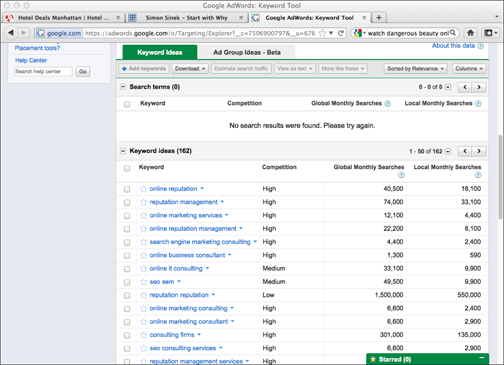
From this point, there are many ways you can refine your settings and rearrange how your search information is displayed. For example, you can click on Global Monthly Searches to have your results ordered in terms of the highest number of clicks.
Exploring paid options
If you’d rather use a reputable service to perform your keyword research, the following screenshots show you my best suggestions. Many of them help you to organize your keywords according to projects or an area of expertise, which I find very handy:
![]() Wordtracker: Wordtracker is a service that helps you to find the keywords relevant to your brand that aren’t being used by your competitors. It gives you a better chance of getting found via search engines. You can check it out at
Wordtracker: Wordtracker is a service that helps you to find the keywords relevant to your brand that aren’t being used by your competitors. It gives you a better chance of getting found via search engines. You can check it out at www.wordtracker.com
. (See Figure 6-6.) It offers
• A free seven-day trial on the entire site, though you have to enter your credit card information, phone number, and e-mail address
• Keyword research
• Link-building tool
• A “Strategizer” tool that helps you to find keywords that only a few competitors are using
Figure 6-6: Wordtracker keyword research tool.
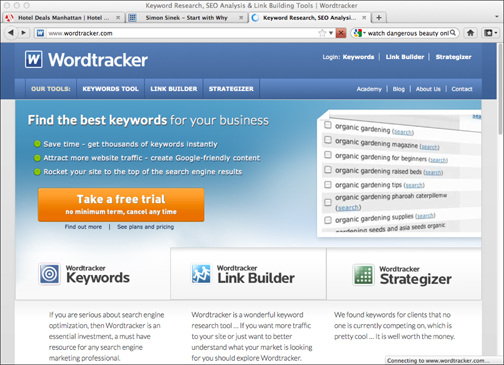
![]() KeywordSpy: KeywordSpy (
KeywordSpy: KeywordSpy (www.keywordspy.com
) shows you the keywords your competitors are using. (See Figure 6-7.) It offers
• A lifetime free trial, only your e-mail address is required
• Fairly limited access via the free trial, with different priced options if you subscribe
• Keyword research
• Link-building tool
• Tools for finding profitable keyword+ ad copy combinations
Figure 6-7: KeywordSpy research tool.

![]() Keyword Discovery (a/k/a Trellian.com, Above.com, PrioritySubmit, or NeedMoreHits): Keyword Discovery (
Keyword Discovery (a/k/a Trellian.com, Above.com, PrioritySubmit, or NeedMoreHits): Keyword Discovery (www.keyworddiscovery.com
) offers tools that optimize and promote your web pages, to increase your website traffic and search engine visibility. (See Figure 6-8.) It offers many things, but these are probably going to be the most useful ones for you:
• A limited free trial, it requires your e-mail address and phone number
• Fairly limited access via the free trial, with different priced options if you subscribe
• Keyword research
• Spelling mistake research
• Seasonal search trends
• eBay and shopping keywords database
SEO keywords are a rich topic and can bring a wealth of power to your online reputation management strategy. Use them wisely. Update them every three to six months, depending on your industry. Make sure everybody in your organization has access to them and uses them often.
Now your efforts can be integrated, powerful, and congruent with your organization’s internal communication. Aren’t you glad you did your research?
Figure 6-8: Keyword Discovery research tool.
